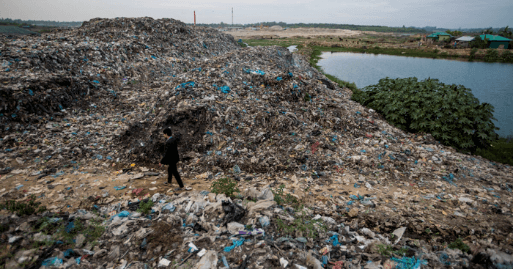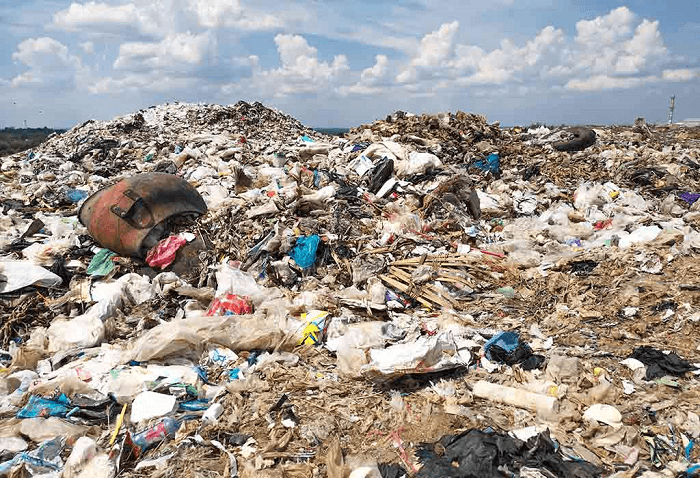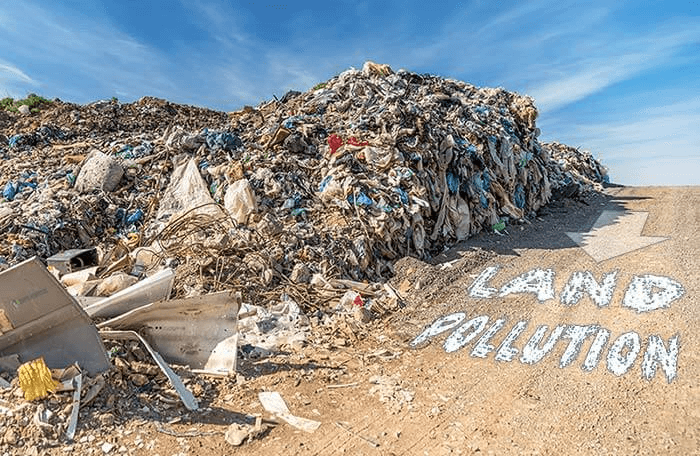Land Pollution DefinitionThe degradation of the land surfaces of the Earth is defined as land pollution. Additionally, it primarily happens as a result of human activity's direct and indirect impacts. Similar to how when we abuse natural resources, land contamination decreases. 
IntroductionLand contamination is a serious problem that needs to be resolved right away. Unneeded substances can harm our land's quality. One type of land pollution is, for instance, the trash that is left on the streets. We should also be aware of the fact that the planet is becoming more and more polluted. As a result of human activity, our world is being harmed by numerous types of pollution. Land contamination is one of these. We are all aware that land contamination causes just as much suffering and ruin. We must thus identify the causes of this contamination and develop preventative measures. Human activities are carried out in the name of development, and this has a significant negative impact on the land, as seen by land contamination. When it is said to be a significant impact, it means any action that reduces the land's production and quality as a prime location for construction, forestry, agriculture, etc. Land pollution is, in other words, the deterioration of land that may be productively employed. After decades of carelessness, we have now realized that land pollution has caused a number of problems. An alarming ratio is developing between the rise in the number of deserted land parcels and the decline in the number of forested areas. Causes of Land PollutionThis contamination is a result of a variety of factors. Land pollution is mostly caused by the wide variety of pollutants that leak onto the land. These compounds also come from a variety of places. These are some of the most common causes of land pollution: 1. Factories WasteFactories are a major source of land contamination. They produce toxic waste and chemicals, which seriously harms the environment. Additionally, these factories discharge their waste into lands and waterways. While some nations have strict laws prohibiting this, others do not. This makes the land more polluted. 2. GarbageThis is a substantial contributor to land contamination. We will discover trash in every home. Every year, ordinary and domestic households produce tonnes of trash. When that much is produced, there are problems with how it is disposed of. As a result, all of this trash is dumped on the ground. A landfill is an area used for waste disposal. In essence, it is a waste of free land that also results in new issues. Let's say that these dumps release a harmful gas that damages both the ozone layer and living things. 3. Farming TechniquesWe are all aware of how important farming is to everyone. They satisfy our requirements and cravings for nourishment. However, some careless farming practices can occasionally do too much harm. Removing forests to make room for farming, which encourages land contamination. Additionally, the land is harmed by the fertilizers and insecticides sprayed on crops. The usual nutrient cycles among plants, soil, & animals are badly interrupted when animal production increases and becomes disconnected from agricultural production. This leads to the extensive use of artificial insecticides, herbicides, bactericides, and even fertilizers, nearly all of which cause pollution. 4. Nuclear PollutantsAdditionally, radioactive remains from nuclear explosions as well as waste from nuclear laboratories and power plants contaminate the earth. Radioactive substances can persist in soil for a very long time because of their lengthy half-life. 5. MiningMining has the ability to harm biodiversity and ecosystems, contaminate the air and water supply, and radically change natural landscapes. But it is yet another activity that pollutes the soil. We drill holes into the ground to collect minerals and coal. Due to this, land erodes. In the same way, it releases pollutants and dangerous fumes, contaminating the air and the land. 6. UrbanizationWe have been constructing permanent communities for at least 10,000 years. As a result of thousands of years into the future, the majority of the towns, cities, and infrastructure will still be around. Land pollution is necessarily caused by large populations residing close to one another, creating rubbish, and dumping in a populated area. Construction work is also done to suit our growing population, which generates a lot of waste materials like metal, plastic, wood, and bricks. These materials add to the area's land pollution when they are not disposed of appropriately. Working with partners who provide comprehensive solutions is essential to achieving cost-effective development recycling and trash disposal strategies, which will assist reduce the negative environmental effects of construction sites. 
Effects of Land PollutionThe effects of land contamination on people's bodies can be numerous. People are capable of ingesting pollutants and toxic waste. Land contamination is also a result of the dangerous disposal of radioactive waste. Long-term health effects can include brain damage, heart disease, lung cancer, chronic respiratory disease, and lung cancer. The following list includes several effects of land pollution:

Prevention of Land PollutionGiven the severe implications of land pollution, it is imperative to take preventative actions to lessen its effects in the future. There isn't a magic bullet to solve the problem of land pollution; it will take work on several fronts. 1. Practises for Sustainable AgricultureFinding alternatives will assist in lessening the impact on the environment because the use of pesticides and other chemicals in the agricultural sector significantly contributes to land pollution. For instance, farmers can use organic components by switching to manure instead of bio-fertilizers or by enlisting in programmes offering sustainable farming information and resources. Supporting local, environmentally conscious farmers at your neighbourhood farmer's market or grocery shop can encourage them to adopt more environmentally friendly farming methods. Contribute to or assist in a neighbourhood urban garden as an additional option. 2. ReforestationReforestation entails planting new trees in a location. For example, this may be required in places that have recently had wildfires or where trees have been felled and processed. By helping to bond the soil, this process shields it from land contamination, reduces soil erosion, and reduces flooding. 3. Treatments for Solid WasteUntreated solid waste can result in a rise in the concentration of harmful and toxic compounds in the soil. Land pollution can be decreased with the aid of chemical treatment techniques used in a controlled setting. This method of treating solid waste also involves neutralization. Before being placed into landfills, trash undergoes this treatment to change its pH level. 4. Reducing, Reusing, and RecyclingWe may all take a number of steps to lessen our personal impact on land contamination. Reusing or recycling products is one of the easiest methods to achieve this, as it prevents waste from being made of materials or objects that still have utility. Recycling is now more accessible than ever because of increased recycling bin availability and increased public awareness of what may be recycled. 5. CompostingComposting is another approach to lessen land pollution. Food scraps and garden trash together currently account up more than 30% of what we throw away but might be composted, according to a report from "The United States Environmental Protection Agency." The environment won't be harmed by the use of waste goods that are reduced and reused.
Next TopicLandscape Definition
|
 For Videos Join Our Youtube Channel: Join Now
For Videos Join Our Youtube Channel: Join Now
Feedback
- Send your Feedback to [email protected]
Help Others, Please Share










